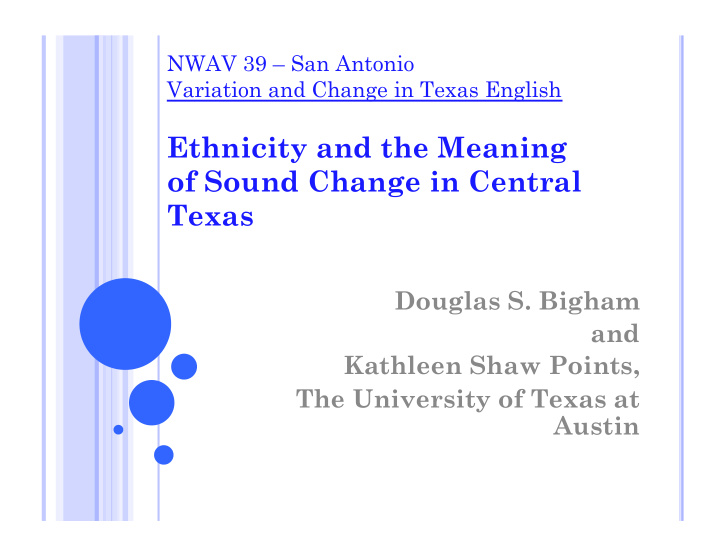



NWAV 39 – San Antonio Variation and Change in Texas English Ethnicity and the Meaning of Sound Change in Central Texas Douglas S. Bigham and Kathleen Shaw Points, The University of Texas at Austin
Texas English Associated with South Midland and Southern speech (Bailey & Tillery 2006; Bailey et al 1991; ANAE) Dallas area distinct - “Texas South” (ANAE) Accounts based primarily on Anglo speech Dialect features/changes assumed to be Anglo-led (Bailey et al., 1991)
The Texas English Project: Austin and Central Texas Central Texas Waco, Austin, San Antonio, Houston Austin, Texas Medium-sized urban center (<1 million) In the 1990s, Austin’s population grew by 48% and between 2000 and 2006 it was rated as the 3rd most rapidly growing city in America. 65% white, 10% African-American, 30% Latino (53% white, non-hispanic)
Central Texas (Underwood, 1988)
Austin, Texas
Austin, Texas
Sound Change: Ethnolects in Contact Importance of minorities’ roles in majority sound changes (Fought, 2002) Sound change can be either minority- or majority-led Minority speakers assimilate to majority norms Majority speakers adopt minority features for covert prestige (Preston, 1999) When sound changes are minority led… Who has “rights” to the older variant? Why does one variant get used instead of another?
Methodology Participants Female speakers Full adults (older) & emerging adults (younger) (Arnett 2002) Anglo, Latino, African American Span of classes and educational levels Central Texans Data Vowels: TRAP, PRICE, LOT/THOUGHT, GOOSE Word list recitations; interview data F1 and F2 measurements at five points Speculative statistical analysis
Central Texas Vowels
Vowel Shifts in Central Texas PRICE, LOT, THOUGHT, TRAP, GOOSE (Wells, 1982) PRICE: status of monophthongization No difference among ethnicities; PRICE is now a diphthong LOT~THOUGHT: merged or distinct Majority speakers leading the change to merged paradigm TRAP: fronting Minority speakers leading the change to fronted TRAP GOOSE: fronted variant stability Minority speakers leading the change to backed GOOSE
LOT~THOUGHT merger Age: p =.30 Ethnicity: p =.16 Interaction: p =.23
GOOSE backing
GOOSE backing
Variation in the GOOSE vowel Fronted GOOSE Traditional, older, stereotypically ‘Texan’ variant Backed GOOSE Newer, minority-led, younger variant But there’s a huge range of variation within individuals!
Mean F2 of GOOSE by topic
Mean F2 of GOOSE by topic
Is this variation indexical? 2 Hispanic women, mid-50s, from East Austin GOOSE tokens come from interview data Does their GOOSE variation index meaning? YES! F2 of GOOSE correlates to Conversation TOPIC
Mean F2 of GOOSE by topic
Mean F2 of GOOSE by topic
Questions remain… Older, fronted, “traditional” variant = timeless topics Newer, backed, “young” variant = modern topics Reallocation of the fronted GOOSE variant? I’m a True Texan, too! How are backed GOOSE variants perceived?
The End. Thanks to: University of Texas at Austin UT LAITS and DIIA offices, UT Department of English Professor & Mentor Lars Hinrichs Undergraduate Research Assts: Natalie Jung & Chris Spradling The residents of Austin’s East Side Texas English Project: www.texasenglish.org Douglas S. Bigham: douglas.s.bigham@gmail.com Kathleen Shaw Points: kmshaw@mail.utexas.edu
Recommend
More recommend